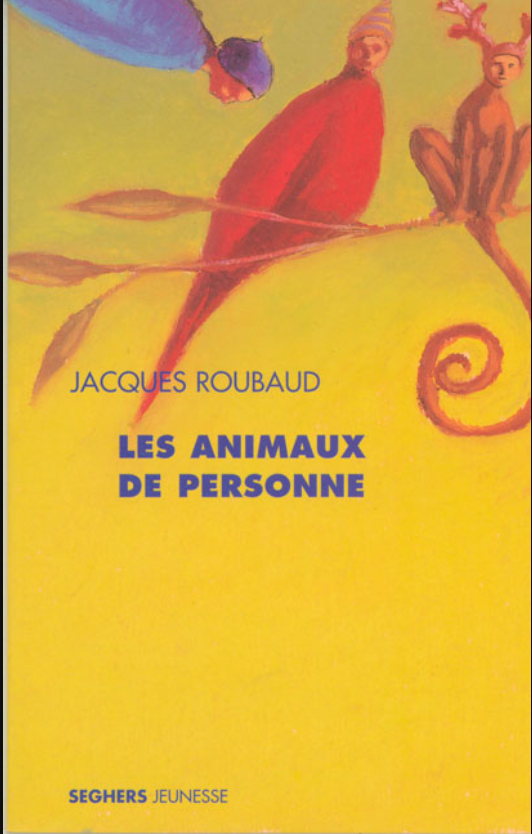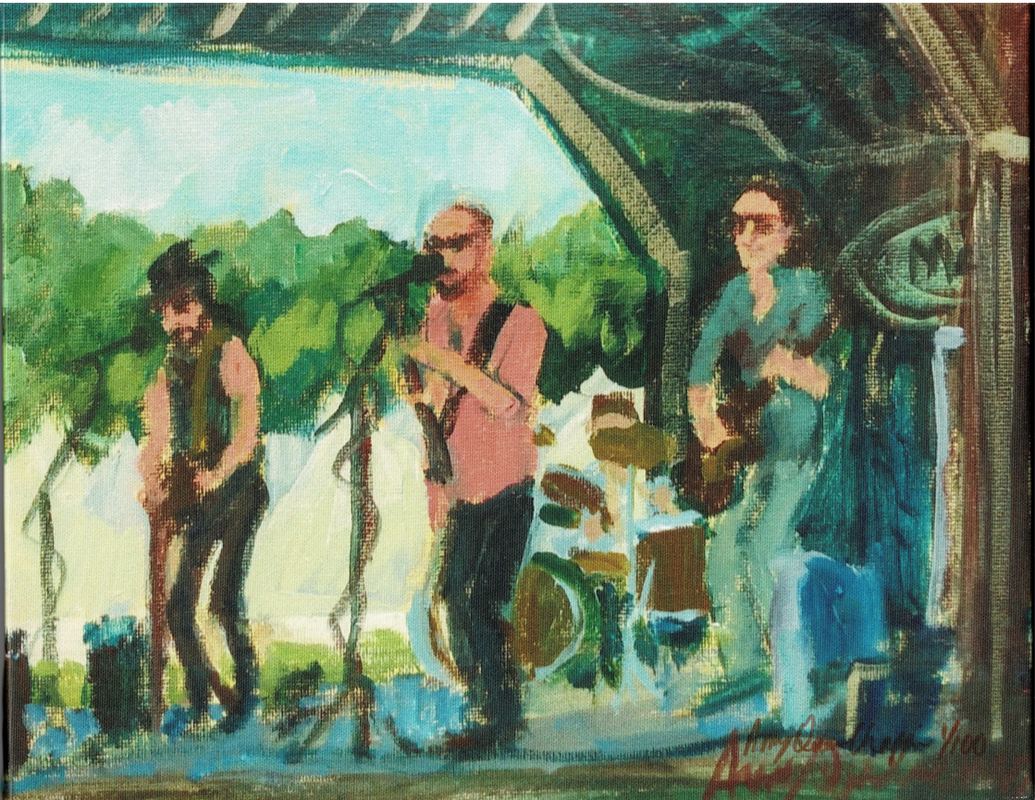|
Some years ago I was interested in the French poets who call themselves Oulipo, for Ouvroir de littérature potentielle, workshop of potential literature—“a loose gathering of (mainly) French-speaking writers and mathematicians who seek to create works using constrained writing techniques” borrowed from games, math, chess, and other fields to widen the possibilities for poetry. For example, Charles Perec wrote a book (“La disparition”) that excludes the letter e (https://en.wikipedia.org/wiki/Oulipo). In my limited forays into the Oulipo, my favorite book is Jacques Roubaud’s “Les animaux de personne,” a playful book of poetry written primarily for children. My favorite poem is the title poem, excerpted below. In this poem, the author speaks to the animals in irregularly rhyming stanzas, of 5-6 lines in length, and the animals reply with a series of out-of-the-way words. At first, I took the animals’ reply to be onomatopoetic cries, and that may well be true. But several years ago, after hours of research (mostly on the web), I discovered that most of the words are names of animals in various languages of Europe, the Americas, Africa, and Asia. L’auteur aux animaux : C’est vous les animaux, les animaux Dont nul ne parle, nul ne dit mot De Cucuron à Carcassonne Pauvres Animaux de Personne ! [The author to the animals: You are the animals about whom no one talks or says a word, from Cucuron to Carcassone, poor animals of nobody.] Les animaux : rüelbar ! cuchumbi ! manaviri !! aswail ! fiael ! fraess ! vielfrass ! jerf ! dimug ! rosomaka ! hyrax ! hyrax ! sakie ! byssinicus ! pitpit ! pitpit ! press ! press ! press ! tana !! Here are my research findings so far; some of the links may no longer be active: rüelbar ! – I haven’t found this one cuchumbi ! Spanish vernacular name for kinkajou (http://commons.wikimedia.org/wiki/Potos_flavus) manaviri !! Another name for kinkajou or honey-bear. According to an early 20th century dictionary, found on Google Books, synonyms are American potto, guchumbi, honey-bear, yellow macaco, yellow lemur, and Mexican weasel. aswail ! The sloth bear (Melursus labiatus) of India. It’s also called the honey-bear (see http://www.pdmpantiqueprints.com/store/By-Subject-Animals-Undomesicated-Nature-39-s-Wild/Honey-Bear-Sloth-Bear-or-Aswail-Melursus-labiatus-/prod_6127.html), so there’s a pattern here. fiael ! I’ve had no luck with this one. Fiel is Spanish for loyal, faithful. An Etymological Glossary of the Shetland & Orkney Dialect, by Thomas Edmondston (found in Google books) provides the following: fiael - Norse, Fiall, a mountain, modern Norwegian Fjel. There is a farm called Fiael situated just at the foot of Roeness Hill, the highest mtn in Shetland. Also one at the foot of Housa-fiael, a hill in Unst, and in other parts of the islands. fraess ! no clue; the context suggests it is a variant of wolverine vielfrass ! (Vielfraß): German word for wolverine jerf ! a Scandinavian word for wolverine; related words—jerv, järv dimug ! no clue. Dimak is one way to translate the Hindi word for termite, but that seems unlikely in this context. It is also an Indonesian word for mug. The context suggests that it refers in some language to wolverine. rosomaka ! Per Wiktionary, this is the Polish word (inflected, I think—perhaps genitive case) for wolverine. Polish: rosomak m: wolverine (Gulo gulo, a mammal) hyrax ! This one I already knew, and it was one of the clues about the nature of the animals’ words. Per Wikipedia: “A hyrax (from Greek ὕραξ "shrewmouse") is any species of fairly small, thickset, herbivorous mammals in the order Hyracoidea.” sakie ! Probably refers to saki, a kind of new world monkey. Wikipedia: “Sakis, or saki monkeys, are any of several New World monkeys of the genus Pithecia. They are closely related to the bearded sakis of genus Chiropotes.” byssinicus ! Probably refers to one or more animals with “abyssincus” in their scientific name. A couple of examples: Arvicanthus abyssinicus=african grass rat; the Abyssinian Ground Hornbill or Northern Ground Hornbill (Bucorvus abyssinicus). pitpit ! I found an interesting (and I hope accurate) blog post: “Pitpit is a Spanish word which refers to this bird we call pipit in both English and Tagalog. … The word could have passed onto to Tagalog by deleting the t in the first syllable for easy pronunciation. Or it could be just through an imitation of its onomatopeic way of singing.” (http://tagalogtranslation.blogspot.com/2004/07/pitpit-is-it-bird-plane.html) press ! – This one has proved hard to find. tana !! – This one has also proved hard to find. Inspired by my research into Roubaud’s poem, I wrote my own, using many of his words and a few of my own discovery. How to Write a Thank You Note Every gift, however trifling, should be acknowledged. —Lillian Eichler Watson, Standard Book of Letter Writing (1948, 1958) Beginning my song of thanks as big as the world: alleluia! For these I am thankful: for cara-rayada and mirikina, for schmalschnauzige and potto and cuchumbi, and for all milky plants, dandelion, milkweed, and sow-thistle: shushuk! bhulan! For names that make me laugh—bouncing bet and pig-sty daisy-- I praise God in brief and simple words: safi! umununi! For plants that grow on roadsides and beautify dumpsters and for those called common—mallow, plaintain, mullein (for I too am common)—I give thanks, as I do for the victuals the wild swine eat—oak mast, prickly pear fruit, and leopard frog. Selah. I am grateful for the devourers, boar and barrow, gilt and sow. For piglet and shoat I sing this hymn of thanksgiving and instruction: O feral hog of Arkansas, O mulefoot from the Mississippi, write the letter quickly, while the glow is still with you! O snuffle-snout and nose-plow, the words will come of their own accord! You bacon- and chitterling-maker, it’s more gracious to mention the gifts, the sowbread, grub and fawn, for which you give thanks. For khuk and budur, for the moon in her cirrus boa whose silvery snout roots up the truffles of the stars, who sweet-cures the dreams she sends to my beloved, I will always give thanks. Scham-scham! Zizel and susel! Hallelujah! • cara-rayada—Spanish for the stripe-faced monkey • mirikina—Spanish for owl monkey • schmalschnauzige—The Indian, small-snouted dugong • potto, cuchumbi—names for the kinkajou or honey-bear • shushuk—the South Asian river dolphin • bhulan—Indus sub-species of the South Asian river dolphin • safi – rabbitfish found in the Persian Gulf • scham-scham—The spotted phalanger found in the Moluccas where, in Wagiou, it is (or was, in the mid-19th century) called by this name • zizel—any of several large Eurasian squirrels • susel—Polish for gopher Words not from Roubaud are: • umununi – Kinyarwanda for sunbird • Selah—A word of unknown meaning used more than 70 times in the Hebrew Bible, primarily in Psalms. It may have marked some liturgical action, or emphasized the section of text, or indicated a musical interlude. • khuk—Farsi for pig • budur—The feminine form of the Arabic word for full moon
0 Comments
A couple of years ago, I started spending time on family history work. I am interested not just in the discovery of names and dates, but in the stories. I am especially drawn to those who have been overlooked because they died young, leaving no children to remember them and document their lives.
An old friend, Martha, has always wondered about her mother’s first fiancé, Clyde Hawkins. Clyde was killed somewhere in the Pacific during World War 2. Though he was many thousands of miles away, Lula (Martha’s mother) knew instantly when Clyde had died. When my friend was a girl, her family used to visit Oma at Christmas to remember her lost son. Recently she asked me to find out more about Clyde’s death; I had little to go on but the soldier’s name, his mother’s given name, Oma (probably a nickname) and married name, as well as the family name of Oma’s second husband, Parks. Using Ancestry.com and FamilySearch.org, I was easily able to find an obituary for Clyde (the picture is from his obituary; the source of the obituary was not provided by the person who posted it on Ancestry). He was killed in Hollandia, New Guinea, on June 6 (the newspaper report) or June 11 (his headstone, as seen on Findagrave.com). Perhaps he was wounded on the 6th and died on 11th, but that is speculation. He would not have known that the invasion of Normandy had begun on June 6. The newspaper story says only that Clyde died from the accidental discharge of a weapon. The family story is more tragic: the weapon that accidentally fired was being cleaned by Clyde’s best friend. Lula thought her chances of marriage ended with Clyde’s death, but a few years later, on the county bus, she met Talmadge. Though he was 16 years older, had already been married, and had children not much younger than Lula, they fell in love, raised their own family, and had a successful married life. Oma died in 1975, shortly after her 77th birthday. Talmadge died in his hundredth year, a few years before Lula. He was still two-finger typing letters on a blue Royal portable, still an astute reader of the newspapers. Edited: 8 August 2022 I acted too slowly to obtain the original, but the artist very kindly produced a print--the 1st of a limited run of 100. It is a fine souvenir of an interested performance and of an entertaining day with Patti. If I do another big reading (I've had three in the past I would call big--60+ plus in attendance; in none of them was I the sole reader) I'll think about commissioning someone to paint it while it's happening.
|
AuthorWrite something about yourself. No need to be fancy, just an overview. Archives
July 2024
Categories |



 RSS Feed
RSS Feed